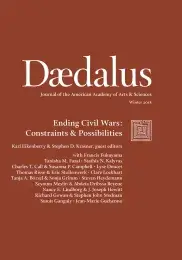Sovereignty Strategies: Enhancing Core Governance Functions as a Postconflict and Conflict-Prevention Measure
This essay contrasts the two extremes used to address civil wars and weak states: costly and ill-designed interventions (Approach A) or minimalist approaches in which international actors either stay away or engage only to broker a deal or depose a dictator, but fail to build institutions and consolidate peace afterward (Approach C). This essay posits an alternative, a sovereignty strategy (Approach B), which would see core functions established in a sequence carefully tailored to context and delivered through partnerships between state, market, and civic actors over a period of decades. It analyzes whether a sovereignty strategy could be both feasible and affordable as an alternative to Approach A or C, whose costs are also very real, taking into account the costs and benefits of each option.
Our international order rests on the assumption that sovereign states will keep the peace within their borders. When this assumption proves wrong, and states begin to break down, or begin to fall into internal conflict that they are unable or unwilling to prevent, the international community is left with difficult choices. The community of nations can let the conflict run its course, attempt to alter its course, or end it by imposed or negotiated peace. A last option is to work to address the root causes of conflict so that it can be mitigated or avoided in the first place, or a newly established peace can be sustained.
Over the past decade and a half, the international community’s inclinations have swung between two extremes: either intervening with military forces and large-scale civilian assistance, as in Iraq and Afghanistan, or standing at a distance, either in the hope that the fire will burn itself out, as in Syria, or in the misplaced hope that cutting a peace or independence deal or deposing a dictator without investing the appropriate resources to build institutions and sustain peace will be sufficient, as in South Sudan and Libya. Clearly neither extreme, in these simplified terms, has worked. Making a conflict-ridden country a long-term ward of the international community, with high levels of poorly planned and implemented external assistance, is neither feasible nor desirable, and often worsens the original conflict. On the other end of the spectrum, global neglect of a conflict and its aftermath can yield costs that are as great as those of large-scale intervention, leaving a vacuum that results in regional instability and vast human misery. Neither approach has proven effective for making and sustaining peace.
Somewhere between these two poles there remains a third approach, a sovereignty strategy: that is, helping internal actors establish or restore a core set of governance systems or institutions, building the legitimacy of the state over time, winning the trust and meeting the needs of the people, reducing the reliance of the country on external support, and contributing to the resolution of conflicts before they become violent. This approach, here called Approach B, is distinct both from the large-scale external aid model (Approach A) that has largely prevailed since 2001 and from the minimalist approach (Approach C).1 The sovereignty strategy approach will not be possible or appropriate in all cases, as each context is unique and what is appropriate and feasible will, of course, depend on the characteristics of the situation. But it could prove more effective and less costly than other options in the right circumstances.
. . .
